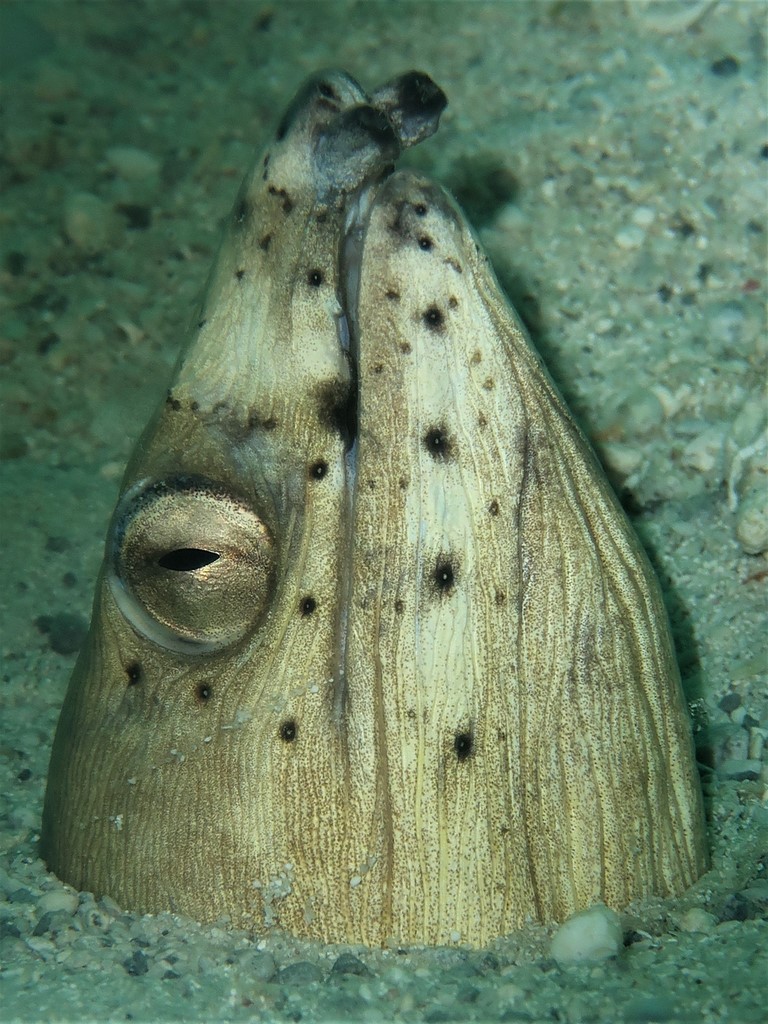OPHICHTHUS ALTIPENNIS - (KAUP, 1856)
Picture courtesy of: Alain Daoulas
Actinopterygii (Gigaclass) > Actinopteri (Class) > Teleostei (Subclass) > Elopomorpha (Superorder) > Anguilliformes (Order) > Congroidei (Suborder) > Ophichthidae (Family) > Ophichthinae (Subfamily) > Ophichthus (Genus)
Anguille-serpent à nageoire haute, Highfin Snake Eel, Tongari-hotate-umihebi, ホタテウミヘビ, 돛물뱀, 帆鰭豆齒鰻,
Synonymes
Microdonophis altipennis (Kaup, 1856)
Ophichthus melanochir (Bleeker, 1864)
Ophichthys melanochir (Bleeker, 1864)
-------------------------
Description
Lateral line pores: 7-9 predorsal, 55-61 preanal; Pectoral fin rays: 16-18; Vertebrae (total): 177-182, 8-9 predorsal, 52-59 preanal; Mean vertebral formula 9-57-179. Head long: 9.3-10.4 in TL; Body depth: 25-38 in TL; Tail length: 1.6-1.7 in TL, tapering rapidly; Snout acute, its length: 20.0-24.4% HL; Three preopercular pores; Body moderately elongate; Dorsal and anal fins elevated; Dorsal fin origin above or slightly in front of gill openings; Pectoral fins elongate. Two small barbels along ventral edge of upper lip (below eye and behind anterior nostril). Teeth conical and none enlarged, uniserial on jaws and vomer. Max. length: 103.0 cm TL. Depth range: 10 - 15 m.
Actinopterygii (Gigaclass) > Actinopteri (Class) > Teleostei (Subclass) > Elopomorpha (Superorder) > Anguilliformes (Order) > Congroidei (Suborder) > Ophichthidae (Family) > Ophichthinae (Subfamily) > Ophichthus (Genus)
Anguille-serpent à nageoire haute, Highfin Snake Eel, Tongari-hotate-umihebi, ホタテウミヘビ, 돛물뱀, 帆鰭豆齒鰻,
Synonymes
Microdonophis altipennis (Kaup, 1856)
Ophichthus melanochir (Bleeker, 1864)
Ophichthys melanochir (Bleeker, 1864)
-------------------------
Description
Lateral line pores: 7-9 predorsal, 55-61 preanal; Pectoral fin rays: 16-18; Vertebrae (total): 177-182, 8-9 predorsal, 52-59 preanal; Mean vertebral formula 9-57-179. Head long: 9.3-10.4 in TL; Body depth: 25-38 in TL; Tail length: 1.6-1.7 in TL, tapering rapidly; Snout acute, its length: 20.0-24.4% HL; Three preopercular pores; Body moderately elongate; Dorsal and anal fins elevated; Dorsal fin origin above or slightly in front of gill openings; Pectoral fins elongate. Two small barbels along ventral edge of upper lip (below eye and behind anterior nostril). Teeth conical and none enlarged, uniserial on jaws and vomer. Max. length: 103.0 cm TL. Depth range: 10 - 15 m.
Color
Anterior dorsal-fin membrane with a distinct dark blotch; Cephalic sensory pores margined dark brown, with additional rows of black pits on snout, cheek and lower jaw; Body without obscure bars (both in life and preservation). A prominent pale spot before eye and a smaller pale spot on snout above anterior nostril.
Etymology
Ophichthus: from Greek, ophis = serpent + from Greek, ichthys = fish. Referring to snake-like appearance.
altipennis: from Latin, altus = high + from Latin, penna, pennae = wing, fin or feather, especially a flight-feather. Referring to greatly developed fins, especially high dorsal fin
Original description: Microdonophis altipennis Kaup, 1856 - Type locality: Makassar, Sulawesi Selatan, Sulawesi Island, Indonesia.
Distribution
Indo-West Pacific: ?Mayotte (France); Maldives and west coast of India, east to Marshall Islands and Society Islands (French Polynesia), north to Korea and Japan, south to Western Australia, Queensland (Australia) and New Caledonia.
Biology
A benthic and burrowing species which occurs over soft bottoms of inshore waters. Feeds on cephalopodes, crustaceans and small fishes. Solitary in sand, often with head protruding.
Similar species
Ophichthus zophistius (Jordan & Snyder, 1901) - Reported from Northwestern Pacific: China, Taiwan, Korea, Japan, and one specimen pelagic in central northwestern Pacific Ocean at 28°21.5’N 135°01.7’E.
Anterior dorsal-fin membrane with a distinct dark blotch; Cephalic sensory pores margined dark brown, with additional rows of black pits on snout, cheek and lower jaw; Body without obscure bars (both in life and preservation). A prominent pale spot before eye and a smaller pale spot on snout above anterior nostril.
Etymology
Ophichthus: from Greek, ophis = serpent + from Greek, ichthys = fish. Referring to snake-like appearance.
altipennis: from Latin, altus = high + from Latin, penna, pennae = wing, fin or feather, especially a flight-feather. Referring to greatly developed fins, especially high dorsal fin
Original description: Microdonophis altipennis Kaup, 1856 - Type locality: Makassar, Sulawesi Selatan, Sulawesi Island, Indonesia.
Distribution
Indo-West Pacific: ?Mayotte (France); Maldives and west coast of India, east to Marshall Islands and Society Islands (French Polynesia), north to Korea and Japan, south to Western Australia, Queensland (Australia) and New Caledonia.
Biology
A benthic and burrowing species which occurs over soft bottoms of inshore waters. Feeds on cephalopodes, crustaceans and small fishes. Solitary in sand, often with head protruding.
Similar species
Ophichthus zophistius (Jordan & Snyder, 1901) - Reported from Northwestern Pacific: China, Taiwan, Korea, Japan, and one specimen pelagic in central northwestern Pacific Ocean at 28°21.5’N 135°01.7’E.
Pisodonophis boro (Hamilton, 1822) - Reported from New Caledonia - Link to the species (here).
Pisodonophis cancrivorus (Richardson, 1848) - Reported from Red Sea; Indo-West Pacific: Eastern Cape and KwaZulu-Natal (South Africa), East Africa, Mayotte (France), Madagascar and western Mascarenes (La Réunion, Mauritius), east to French Polynesia, north to Korea and Japan, south to Australia (Northern Territory and Queensland).
Pisodonophis cancrivorus (Richardson, 1848) - Reported from Red Sea; Indo-West Pacific: Eastern Cape and KwaZulu-Natal (South Africa), East Africa, Mayotte (France), Madagascar and western Mascarenes (La Réunion, Mauritius), east to French Polynesia, north to Korea and Japan, south to Australia (Northern Territory and Queensland).
Ophichthus sangjuensis (Ji & Kim, 2011) - Reported from Eastern Indian Ocean, northwestern Pacific: West Bengal (India); southern Korea and Japan. Depth range: 2 - 40 m.
Last update: 29, May 2024
